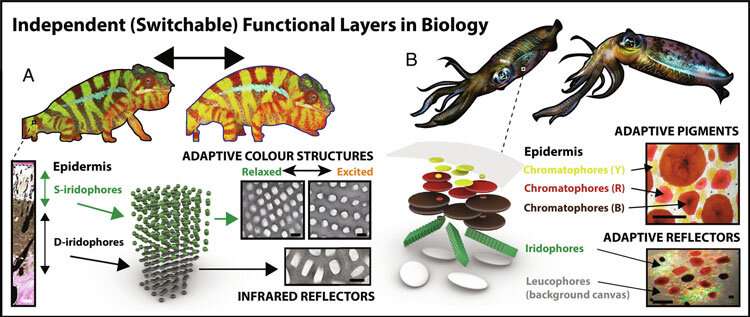Liquid windows: Energy-saving inspiration from squid skin
Inspired by the dynamic color-changing skin of organisms such as squid, University of Toronto researchers have developed a multilayered fluidic system that can reduce the energy costs of heating, cooling and lighting buildings.
The platform, which optimizes the wavelength, intensity and dispersion of light transmitted through windows, offers much greater control than existing technologies while keeping costs low due to its use of simple, off-the-shelf components.
“Buildings use a ton of energy to heat, cool and illuminate the spaces inside them,” says Raphael Kay, who recently graduated with a master’s degree in mechanical engineering from the Faculty of Applied Science & Engineering and is lead author on a new paper published in the journal PNAS.
“If we can strategically control the amount, type and direction of solar energy that enters our buildings, we can massively reduce the amount of work that we ask heaters, coolers and lights to do.”
Currently, certain “smart” building technologies such as automatic blinds or electrochromic windows—which change their opacity in response to an electric current—can be used to control the amount of sunlight that enters the room. But Kay says that these systems are limited: they cannot discriminate between different wavelengths of light, nor can they control how that light gets distributed spatially.
“Sunlight contains visible light, which impacts the illumination in the building—but it also contains other invisible wavelengths, such as infrared light, which we can think of essentially as heat,” he says.
“In the middle of the day in winter, you’d probably want to let in both—but in the middle of the day in summer, you’d want to let in just the visible light and not the heat. Current systems typically can’t do this—they either block both or neither. They also have no ability to direct or scatter the light in beneficial ways.”
Developed by Kay and a team led by Associate Professor Ben Hatton, the system leverages the power of microfluidics to offer an alternative. The team also included Ph.D. candidate Charlie Katrycz, both in the department of materials science and engineering, and Alstan Jakubiec, an assistant professor in the John H. Daniels Faculty of Architecture, Landscape, and Design.
The prototypes consist of flat sheets of plastic that are permeated with an array of millimeter-thick channels through which fluids can be pumped. Customized pigments, particles or other molecules can be mixed into the fluids to control what kind of light gets through—such as visible versus near-infrared wavelengths—and in which direction this light is then distributed.
These sheets can be combined in a multi-layer stack, with each layer responsible for a different type of optical function: controlling intensity, filtering wavelength or tuning the scattering of transmitted light indoors. By using small, digitally controlled pumps to add or remove fluids from each layer, the system can optimize light transmission.
“It’s simple and low-cost, but it also enables incredible combinatorial control. We can design liquid-state dynamic building facades that do basically anything you’d like to do in terms of their optical properties,” Kay says.

The work builds on another system that uses injected pigment, developed by the same team earlier this year. While that study drew inspiration from the color-changing abilities of marine arthropods, the current system is more analogous to the multilayered skin of squid.
Many species of squid have skin that contains stacked layers of specialized organs—including chromatophores, which control light absorption, and iridophores, which impact reflection and iridescence. These individually addressable elements work together to generate unique optical behaviors that are only possible through their combined operation.
While the U of T Engineering researchers focused on the prototypes, Jakubiec built detailed computer models that analyzed the potential energy impact of covering a hypothetical building in this type of dynamic facade.
The models were informed by physical properties measured from the prototypes. The team also simulated various control algorithms for activating or deactivating the layers in response to changing ambient conditions.
“If we had just one layer that focuses on modulating the transmission of near-infrared light—so not even touching the visible part of the spectrum—we find that we could save about 25% annually on heating, cooling and lighting energy over a static baseline,” says Kay.
“If we have two layers—infrared and visible—it’s more like 50%. These are very significant savings.”
In the most recent study, the control algorithms were designed by humans, but Hatton points out that the challenge of optimizing them would be an ideal task for artificial intelligence—a possible future direction for the research.
“The idea of a building that can learn—that can adjust this dynamic array on its own to optimize for seasonal and daily changes in solar conditions—is very exciting for us,” Hatton says.
“We are also working on how to scale this up effectively so that you could cover a whole building. That will take work but given that this can all be done with simple, non-toxic, low-cost materials, it’s a challenge that can be solved.”
Hatton also hopes that the study will encourage other researchers to think more creatively about new ways to manage energy in buildings.
“Globally, the amount of energy that buildings consume is enormous—it’s even bigger than what we spend on manufacturing or transportation,” he says. “We think making smart materials for buildings is a challenge that deserves a lot more attention.”
More information:
Raphael Kay et al, Multilayered optofluidics for sustainable buildings, Proceedings of the National Academy of Sciences (2023). DOI: 10.1073/pnas.2210351120
Citation:
Liquid windows: Energy-saving inspiration from squid skin (2023, February 1)
retrieved 1 February 2023
from https://techxplore.com/news/2023-02-liquid-windows-energy-saving-squid-skin.html
This document is subject to copyright. Apart from any fair dealing for the purpose of private study or research, no
part may be reproduced without the written permission. The content is provided for information purposes only.
For all the latest Technology News Click Here
For the latest news and updates, follow us on Google News.
